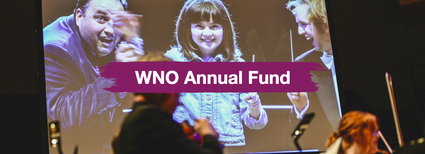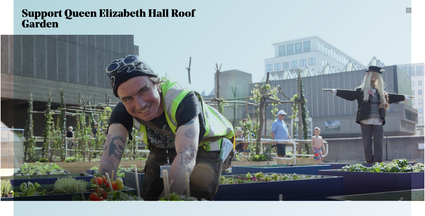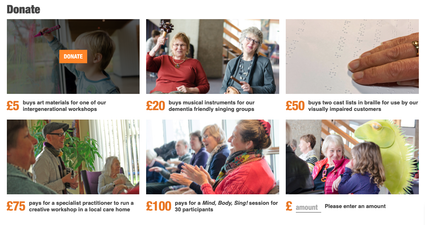How easy is it to donate online?

To celebrate Giving Tuesday I ran a little experiment. I attempted to donate to 15 arts, cultural and heritage organisations to test online donation processes.
The organisations span the country, including Wales, Scotland, and Ireland. They all use one of three CRM systems (Spektrix, Tessitura and Ticketsolve), and have websites created by various agencies.
I went to each site to donate up to £5 (although for most I wanted to donate between £1 and £2).
I wanted to look at a few specific parts of the donor journey:
- How many clicks does it take to donate?
- How easy is the purchase path for a new customer?
- Which organisations had the most compelling messaging?
- How was I thanked for my donation?
Caveat: This isn’t the most scientific experiment! 15 websites isn’t a huge data set, and I chose organisations I knew of. Some of them I know well, others I don’t. It is worth saying that each organisation will have its own fundraising goals and strategies, and I just might not be the kind of donor they’re trying to attract!
How many donations did I make?
I managed to make eight donations in total. The smallest was £1, the biggest was £5. I didn’t donate to the other seven organisations because:
- Three didn’t have the option to make a one-off gift; I could only join as a Patron or Member.
- One asked for a minimum one-off gift of £25; I couldn’t see how to donate less
- One asked me to fill in a form
- I hit errors on two websites, and couldn’t add a donation to the basket
Purchase paths
Of the donations I did make, the average number of clicks from homepage to confirmation was 14.5. (Welsh National Opera was just 10 clicks!)
Unsurprisingly, most of the organisations sold tickets, so the purchase path was very much focused on ticket purchasing. This included one organisation forcing me to select a delivery method for my ‘tickets’, and one having ‘Book Now’ on all the checkout buttons.
Possibly the most confusing process was where I was asked if I wanted to donate when I'd already added a donation to the basket.
The best experience were on websites that offered Guest Checkout (Buxton Opera House being one). Although I still had to enter my address and full details, the process was clearer, and similar to other online purchasing experiences.
This is a really tricky area for fundraisers in the arts sector. There’s a limit to the tools and functionality available to them in their CRM systems. It’d be great to see more flexibility here, and for systems to be able to differentiate between someone purchasing tickets and someone making a donation.
Thank you!
This is where the process really didn't work for any of the donations I made. But, this is largely a symptom of the organisations being venues where the purchase path is focused on ticket sales rather than donations.
I received receipts for most of my donations immediately. Most are very formal and not very exciting. (and I’m still waiting for a few!)
The best one came from Chichester Festival Theatre who’ve added custom text to their confirmation email:
Thank you for your donation of £1.50 to Ageless appeal (online donation). We will reclaim gift aid on this donation. A further confirmation from one of our team will follow in the coming days.
Being a registered charity, we rely on the generous support of donors like you to run our continued productions of world class theatre, and for the important work we do in the local community. We couldn’t do it without you! Moreover, with gift aid, we can reclaim a further 25% on top of your donation.
Please get in touch if you would like to know more about the many different ways of being involved with and supporting our work, plus the exclusive benefits we offer to show our gratitude for such support. You can call us on 01243 812908 or email development.team@cft.org.uk.
(The worst experience was with an organisation who didn’t use the words ‘Thank You’ at any point – either during the donating process, or in the confirmation email!)
Compelling case for support?
The ask and case for support varied hugely across the sites. Two of my favourites were Edinburgh Lyceum who have a lovely video, and the Southbank Centre who had images and calls to action clearly laid out – and I got to donate to a roof garden!

In general, pages which were image-led felt more exciting and enticing. (Opera North have used images really well on their support pages.)
Shorter cases for support stood out, especially Wales Millenium Centre’s. Where the case for support was longer, I can’t say I read every word, especially the one organisation whose case for support was a rather long 368 words.
Tangible benefits really helped my small donations feel significant – Chichester Festival Theatre and WNO provide excellent examples of this.


Tips from a would-be donor
Although only a small experiment, it highlights some of the pitfalls when it comes to soliciting online donations.
I’ve written before about how useful the Support Page is. One of its very important tasks is to provide a means for people to donate – whenever they like, and wherever they are.
To make sure your website is going to get the best donations, here are my tips:
- Test your website regularly (the two websites with errors probably wouldn’t take long to fix, but it’s rare that a donor will go to the effort of pointing out your website is broken);
- Keep the case for support short and sweet;
- Use images! If you’re producing work for the stage, you probably invest a lot in capturing professional images. Think about doing the same for your fundraising content;
- Talk to your CRM provider and web agency about the options for custom messaging in the purchase path. Wherever possible, try to acknowledge – and thank – donors within the standard functionality.